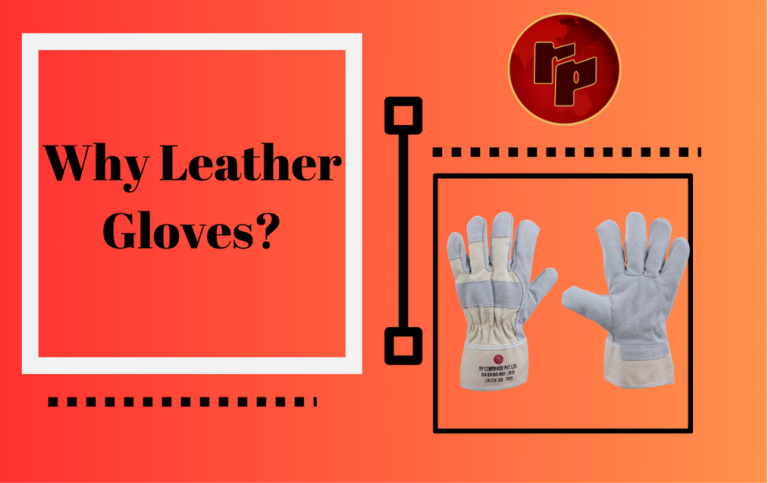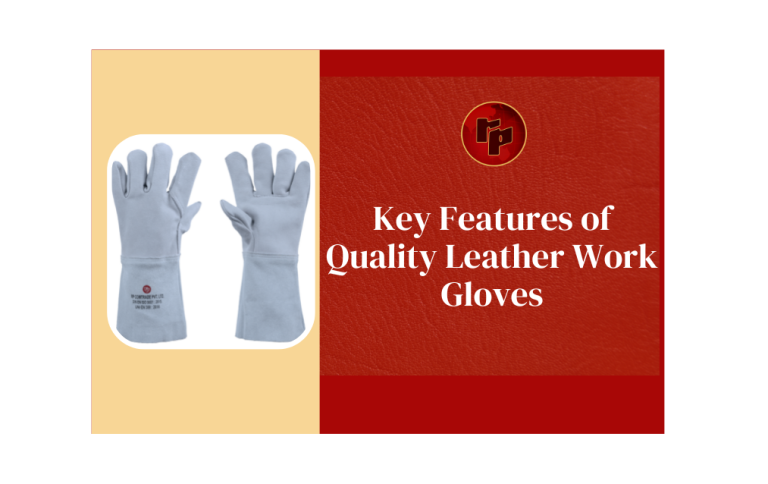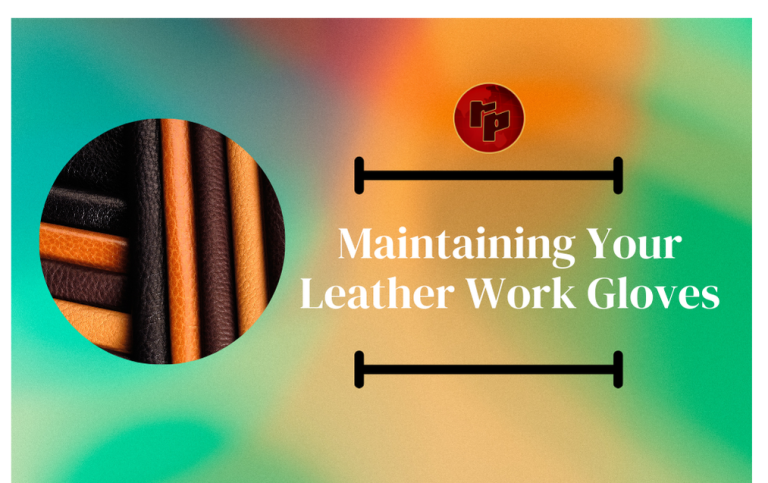Work gloves are used in various industries like construction, healthcare, manufacturing, and agriculture, where safety is the top priority. People working in these industries are exposed to various hazards such as physical dangers, viruses, and chemicals every day. Thus, it becomes important to use quality work gloves to protect the workforce against cuts, thrones, and chemicals and to maintain hygiene and cleanliness in the working environment.
Leather work gloves having exceptional durability, protection, and comfort are considered to be a superior choice for various industrial applications.
So, in this blog, you will understand why leather gloves are important and the key features of quality leather work gloves. How you can choose the right leather work gloves depending upon your needs and the tips to maintain them. Lastly, you will learn some factors that you should consider while choosing safety gloves for yourself.
Continue reading the blog for all the details.

Why Leather Gloves?
Leather has some exceptional characteristics that make it a popular choice for safety gloves. When leather is used as a raw material in these gloves, it makes them more effective, comfortable, and long-lasting in use.
Let’s explore some of the qualities of leather that make it the right choice:
Durability
Leather is a natural material that can withstand wear and tear for a long time. This durable feature of leather gloves makes them a cost-effective choice as they typically outlast many other types of gloves.
Comfort Fit
Leather gloves adapt to the shape of the wearer’s hand, giving them a personalized fit and enhancing comfort. It also has natural breathability, which helps in maintaining a comfortable temperature inside the gloves.
Protective Qualities
Leather gloves have several protective qualities, like protection against cuts and heat. These qualities of protective gloves make them well-suited for environments where hands are exposed to rough or damaging conditions.
Better Grip
The natural textures of the leather gloves offer a superior grip to the wearer’s hand as it enhances their ability to hold onto tools and materials securely. The enhanced feature helps the user to perform their task effectively.

Key Features of Quality Leather Work Gloves
High-quality leather work gloves are essential for providing protection, comfort, and durability in various work environments. Here are the key features to consider when evaluating their quality:
Material Type:
Full-grain leather is regarded as the highest quality leather because it is sourced from the top layer of the hide. This leather has a natural grain and imperfections from the animal skin, are highly used in demanding tasks. which makes it highly durable, flexible, and resistant to wear. The leather gloves made from full-grain leather offer excellent protection and breathability. They are highly used in demanding tasks.
Split-grain leather is less expensive and less durable as it is made from low-quality hides. Still, they provide protection and flexibility and are commonly used in tasks that don’t require much durability.
Construction:
High-quality leather work gloves have the best stitching as they are stitched using heavy-duty, abrasion-resistant threads, which enhances their strength and longevity.
Premium gloves have their palms and knuckles padded. This feature provides comfort, protects against repetitive tasks, and reduces hand fatigue.
Proper Fit and Sizing:
For optimal performance, gloves must fit snugly without being too tight. A proper fit ensures that the gloves do not interfere with dexterity or cause discomfort.
Accurate sizing is essential for comfort and functionality. Proper sizing helps in maintaining grip and control, reducing the risk of hand injuries, and enhancing overall efficiency.

Choosing the Right Leather Work Gloves for Your Needs
When selecting the right leather work gloves, it’s important to consider a range of factors to ensure they meet your specific needs effectively. Here are some key tips to guide your choice:
Industry-Specific Requirements:
Construction and Heavy Machinery: Opt for gloves made from full-grain leather with reinforced stitching and substantial padding. They should offer high abrasion resistance and durability to withstand tough conditions.
Healthcare and Precision Work: Choose gloves with thinner, more flexible leather to provide dexterity and a snug fit. Full-grain leather may be preferred for its superior tactile sensitivity and durability.
Food Industry: Look for gloves that are both durable and easy to clean. Split-grain leather can be a good choice here, but ensure they are also designed to maintain hygiene standards.
Types of Work:
Heavy-Duty Gloves: For tasks involving heavy lifting, rough materials, or exposure to sharp edges, select gloves with thick, full-grain leather and additional padding or reinforcement. These will offer enhanced protection and durability.
Light-Duty Gloves: For tasks requiring more precision or less physical strain, such as light handling or detailed work, opt for thinner leather gloves that provide flexibility and a good grip while still offering protection.
Various Climate Conditions:
Hot and Dry Environments: Choose gloves with breathable leather and a moisture-wicking lining to keep hands cool and comfortable. Full-grain leather often provides better breathability.
Cold and Wet Conditions: Look for gloves with additional insulation and water-resistant treatments. Leather gloves with a protective coating or lining can help keep hands warm and dry in colder climates.

Maintaining Your Leather Work Gloves
Maintaining leather work gloves properly can significantly extend their lifespan and ensure they continue to provide reliable protection and comfort. Let’s see some practical tips that will help you keep your leather gloves in top condition:
Effectively Cleaning Leather Gloves:
Remove Dirt and Debris: After each use, brush off any loose dirt or debris with a soft brush. For stubborn dirt, use a damp cloth to gently wipe the gloves. Avoid soaking the gloves in water, as excessive moisture can damage leather.
Clean with Leather Cleaner: Use a leather-specific cleaner to treat more ingrained stains. Using a delicate cloth and a tiny bit of cleanser, gently wipe the leather in circular motions. Follow the product’s instructions for best results and ensure you remove any excess cleaner.
Keeping Leather Supple and Functional:
Condition Regularly: Leather can dry out over time, so use a leather conditioner to keep it supple and prevent cracking. Apply the conditioner sparingly with a soft cloth, following the product’s instructions. This helps maintain the leather’s flexibility and durability.
Avoid Excessive Heat: Keep gloves away from direct heat sources like radiators or sunlight, which can dry out and damage the leather. Allow them to air dry naturally if they get wet.
Proper Storage Techniques:
Store in a Cool, Dry Place: When not in use, store your gloves in a cool, dry environment to prevent mold and mildew growth. Avoid damp or humid areas.
Use a Shape Retainer: To help maintain their shape, consider using a glove form or stuffing them with paper when storing. By doing this, they avoid getting creases or being distorted.
Avoid Folding: Store gloves flat rather than folded to prevent creases that can weaken the leather over time.
Safety Considerations
When choosing safety gloves, consider several factors for adequate protection.
Work Safety Standards:
Compliance with Regulations: Ensure the gloves meet industry-specific safety standards and regulations. For example, in the U.S., look for certifications like ANSI/ISEA (American National Standards Institute/International Safety Equipment Association) or ASTM (American Society for Testing and Materials) ratings. In Europe, check for EN (European Norm) standards.
Certification Labels: Verify that the gloves have certification labels indicating they have been tested and meet the required safety criteria for the intended application. This can include standards for cut resistance, puncture resistance, and chemical protection.
Protective Features:
Cut and Abrasion Resistance: Choose gloves with adequate cut and abrasion resistance for tasks involving sharp objects or rough surfaces. Look for materials like Kevlar, metal mesh, or high-dexterity leather.
Puncture and Impact Protection: For environments where sharp objects or impacts are a concern, select gloves with reinforced palms or padding in critical areas to reduce the risk of injuries.
Chemical Resistance: If working with hazardous chemicals, ensure the gloves are made from materials specifically designed to resist chemical penetration, such as nitrile, neoprene, or latex.
Heat and Flame Resistance: For tasks involving high temperatures or flames, choose gloves with heat-resistant materials and designs. This could include gloves lined with insulating materials or made from flame-resistant fabrics.
Grip and Dexterity: Gloves should offer a good grip to prevent slips and enhance control. Materials with textured surfaces or specialized coatings can improve handling. Ensure that the gloves also provide the necessary dexterity for the specific tasks performed.
The Bottom Line
Investing in quality leather work gloves is essential for ensuring optimal work safety and protection. Leather gloves are renowned for their durability and resistance to abrasion, making them a superior choice for a wide range of tasks. By choosing high-quality protective gloves, you not only enhance your own safety but also increase your productivity and comfort on the job. Prioritizing the right gear is a smart investment that pays off by reducing the risk of injuries and prolonging the lifespan of your gloves.
